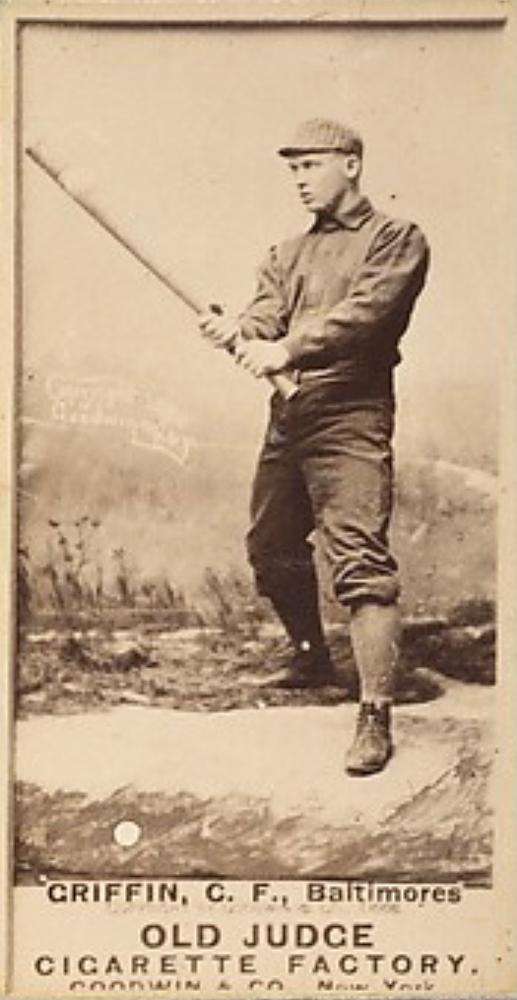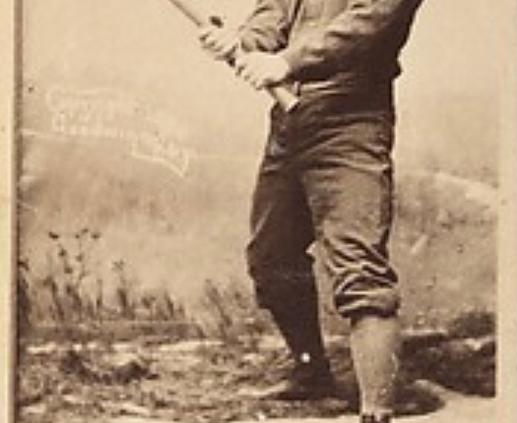April 16, 1887: Mike Griffin becomes first major-league player to homer in his first at-bat — or does he?
 The American Association commenced its sixth season as a major league on April 16, 1887, with a full slate of games. In the top of the first inning of the Baltimore Orioles’ tilt against the Philadelphia Athletics, rookie center fielder Mike Griffin stepped to the plate for his maiden big-league at-bat and promptly hit one over the fence. Griffin thus became the first player to begin his major-league career with a home run. Or so it seemed for more than a century. But then modern-day baseball researchers discovered a remarkable coincidence. On the same day, George Tebeau of the Cincinnati Reds had done the exactly same thing, hitting a home run in the top of the first against the Cleveland Blues in his initial major-league plate appearance.
The American Association commenced its sixth season as a major league on April 16, 1887, with a full slate of games. In the top of the first inning of the Baltimore Orioles’ tilt against the Philadelphia Athletics, rookie center fielder Mike Griffin stepped to the plate for his maiden big-league at-bat and promptly hit one over the fence. Griffin thus became the first player to begin his major-league career with a home run. Or so it seemed for more than a century. But then modern-day baseball researchers discovered a remarkable coincidence. On the same day, George Tebeau of the Cincinnati Reds had done the exactly same thing, hitting a home run in the top of the first against the Cleveland Blues in his initial major-league plate appearance.
The above events beg the question which of these two ancient four-baggers – hit on the same afternoon and in the same top of the first inning – was struck first. Analysis of the situation is complicated by time-zone peculiarities. According to the Baltimore Sun, the Philadelphia-Baltimore game would be “called at 4 o’clock.”1 The game in Cincinnati was advertised to start “at 3:30 o’clock P.M.”2 Because Cincinnati was then situated in the Central Standard Time Zone,3 this ostensibly placed the Blues-Reds game a half-hour behind the contest in Eastern Standard Time Zone Baltimore. At the time, however, Cincinnati, like various other cities removed from the East Coast, did not accept the time regimes that had been imposed for the convenience of the railroads in November 1883. In 1887 Cincinnati remained on its own city time – which was 22 minutes faster than CST.4 That put the scheduled start of the game in Cincinnati only eight minutes behind the time set for the game in Baltimore.
Whether Opening Day festivities or other circumstance delayed the throwing of first pitch in Baltimore or Cincinnati is unknown. So are the number of minutes that may have elapsed before Griffin and Tebeau connected. Still, the probabilities favor Griffin being first, if only slightly. In any case, the narrative herein focuses upon the home run hit by the originally recognized record-holder, Mike Griffin.
Undaunted by “cold and disagreeable” weather,5 a crowd of 4,000 passed through the turnstiles at Oriole Park, aka American Association Park, to see their heroes open the 1887 season against the Philadelphia Athletics. When the home side took the field for pregame warm-ups “outfitted in white shirts and light blue breeches with maroon trimmings … [the team] looked good to Orioles fans.”6 Even more pleasing to the Baltimore faithful was the way that the Orioles lit into Philadelphia starter Ed Seward, a 19-year-old right-hander who had made only one previous major-league appearance – six innings pitched for the National League Providence Grays in 1885.
Exercising their home-field option, the Orioles elected to bat first and promptly put a four-spot on the scoresheet in the top of the first inning against young Seward. Re-creation of game action is hampered by the perfunctory news coverage that the contest received at the time it was played. Still, it seems safe to say that Baltimore had already scored at least one run (and perhaps two) when rookie outfielder Mike Griffin made his first major-league appearance. Slotted sixth in the Orioles lineup by manager Billy Barnie, the 5-foot-7, 160-pound lefty batter did not appear overly menacing, but there was pop in his bat. The newcomer immediately put that power on display, driving a Seward serving “over the fence in the first inning for a home run.”7 Although no great note was then made of the Griffin blast, it was thereafter recognized as the first time a ballplayer had initiated his major-league career by hitting a homer in his very first at-bat.
With Baltimore having an immediate four-run lead, the game’s outcome was not much in doubt. The Athletics faced the unlikely task of making up the deficit against the formidable Matt Kilroy, fresh off a season wherein he had recorded an astonishing 513 strikeouts, still the all-time major-league record.8 The Orioles left-hander held the A’s scoreless until Baltimore tacked on two more runs in the fourth. Philadelphia then scratched out a run. The score had reached 8-1 by the bottom of the eighth inning. Exactly how the Orioles scored those runs appears lost to history, but the hitting exploits of the club’s debutant center fielder are not. Mike Griffin was the hitting star of the game, “making a home run and two doubles, one of the latter being a hit over the left field fence.”9
Meanwhile, the Athletics “were puzzled considerably over Kilroy’s curves and they were unable to get on to his peculiar style,” lamented the Philadelphia Times.10 Only six Philadelphia batsmen reached Kilroy for base hits (not counting the six bases on balls that were counted as hits for batting average purposes under an ill-conceived 1887 season-only statistical dictum). Aided by excellent defense – teammates committed only one fielding error behind him – the Baltimore ace was dominant throughout, never being in serious trouble. A run-scoring double by Ed Flanagan in the eighth plated the A’s second tally before an unearned run registered via a ninth-inning passed ball charged to Orioles backstop Chris Fulmer finalized the scoring at Baltimore 8, Philadelphia 3.
As his maiden season progressed, Griffin demonstrated that his debut-game hitting outburst had not been a fluke. At season end his offensive numbers included a .301 batting average, 48 extra-base hits, and 94 RBIs. Kilroy, meanwhile, became the circuit’s dominant pitcher, winning an AA-leading 46 games for the third-place (77-58-6, .570) Orioles. On the other side, fledgling Philly starter Seward blossomed into a rotation mainstay, splitting 50 decisions evenly for the fifth-place (64-69-4, .481) Athletics.
From there, Griffin went on to a solid 12-year career that ended in 1898. And for more than a century, he was recognized as the first player to begin his major-league tenure with a home run in his maiden at-bat. But now research has uncovered that Cincinnati Reds rookie George Tebeau did exactly the same thing. In a game played against the Cleveland Blues some 500 miles to the west of Baltimore, Tebeau homered in his very first major-league at-bat – on the same day (April 16, 1887) and in the same frame (top of the first inning) as Griffin. The coincidence is obviously remarkable.
Sources
No inning-by-inning account of the Baltimore-Philadelphia game was uncovered. The narrative above has been drawn from wire-service game summaries published nationwide and after-the-fact game commentary published in the Philadelphia Times, April 17, 1887, and Baltimore Sun, April 18, 1887. Reference sources consulted include Baseball-Reference.com and Retrosheet.
Photo credit: Mike Griffin, Trading Card Database.
Notes
1 “Base-Ball … Baltimore Grounds,” Baltimore Sun, April 16, 1887: 1 (advertisement).
2 “Cincinnati Base Ball Grounds,” Cincinnati Commercial Gazette, April 16, 1887: 12 (advertisement).
3 Cincinnati did not shift to the Eastern Standard Time Zone until 1927.
4 Per essays recently published online. See e.g., “How Daylight Saving Time Arrived in Cincinnati,” https://www.tumblr.com/handeaux/140685032432/how-daylight-saving-time-arrived-in-cincinnati.
5 The description of game condition weather published in “Baltimore 8, Athletics 3,” St. Louis Globe-Democrat, April 17, 1887: 18.
6 Preston Orem, Baseball (1882-1891) from the Game Accounts (Altadena, California: Self-published, 1966-1967), 287, accessed via the SABR Research Collection online.
7 As recounted in wire-service game accounts published in the Kansas City Times, New Orleans Times-Democrat, and elsewhere, April 17, 1887.
8 Making the Kilroy record even more remarkable was the fact that a strikeout then consisted of only called and swinging strikes, not foul balls. Balls batted foul were not counted as strikes until the early 1900s.
9 Per “Baltimore vs. Athletics,” New York Clipper, April 23, 1887: 89. The import of this passage is less than clear but perhaps suggests that one of the Griffin two-baggers landed over a short-porch outfield fence that was designated grounds-rule-double territory.
10 “The Ball Season,” Philadelphia Times, April 17, 1887: 2. The “peculiar style” was likely the balk-move Kilroy pitching delivery that other clubs frequently complained about, to no avail.
Additional Stats
Baltimore Orioles 8
Philadelphia Athletics 3
Oriole Park
Baltimore, MD
Corrections? Additions?
If you can help us improve this game story, contact us.


